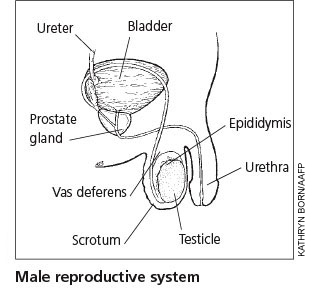
Am Fam Physician. 2004;69(3):619-620
What is cancer?
The body is made up of many kinds of cells. Normally, cells grow, divide, and die. Sometimes, cells change and begin to grow and divide more quickly than normal cells. Rather than dying, these abnormal cells clump together to form tumors. If these tumors are cancerous, they can invade and kill your body's healthy tissues. From these tumors, cancer cells can spread and form new tumors in other parts of the body. By contrast, noncancerous tumors do not spread to other parts of the body.
The prostate gland is part of the male reproductive system (see the picture below). The prostate makes a fluid that mixes with sperm and other fluids during ejaculation. A normal prostate is about the size of a walnut.
Prostate cancer can be aggressive, which means it can grow quickly and spread to other parts of the body. Or it may be slow growing and stay in the prostate, causing few if any problems. Three out of four cases of prostate cancer are of the slow-growing kind that is relatively harmless.

Call your doctor if you have any of these symptoms
Difficulty starting to urinate
Less force to the stream of urine
Dribbling after you finish urinating
Frequent urination
Blood or pus in the urine
Pain or burning feeling while urinating
Pain with ejaculation
Hip or back pain that does not go away over time
Who is at risk for prostate cancer?
Prostate cancer is the most common kind of cancer in American men, other than skin cancer. The American Cancer Society estimates that there will be more than 230,000 new cases of prostate cancer in the United States every year, and that about 29,000 men will die of this disease each year. For an American man, the lifetime risk of getting prostate cancer is 1 in 6.
Although men of any age can get prostate cancer, it is found most often in men older than 50 years. More than eight out of 10 men with prostate cancer are older than 65 years.
Black men are at higher risk than white men. Men with a family history of prostate cancer are at higher risk, too. Family history means that your father or a brother had prostate cancer.
How does my doctor check my prostate?
Your doctor may examine your prostate by putting a gloved, lubricated finger a few inches into your rectum to feel your prostate gland. This is called a digital rectal exam. A normal prostate feels firm. If there are hard spots on the prostate, your doctor may suspect cancer.
What is the PSA test?
Another way to check for prostate cancer is with a blood test called the PSA test. PSA is short for prostate-specific antigen. Men who have prostate cancer may have a higher level of PSA in their blood. However, the PSA level also can be high because of other, less serious causes such as infection.
Who should be screened?
Screening means looking for cancer before it causes symptoms. Some doctors recommend that men at high risk should be screened.
Doctors do not agree on whether screening is needed for men who are not at high risk. The American Cancer Society recommends that doctors offer prostate cancer screening every year to most men older than 50 years after talking with them about the advantages and disadvantages of the screening tests. [ corrected] The National Cancer Institute, the U.S. Preventive Services Task Force, and the American Academy of Family Physicians believe the choice should be left up to patients and their doctors.
What are the disadvantages of screening?
Although screening for prostate cancer finds many cases of cancer, it also finds conditions that are not cancer. This means that some men may have to go through unneeded tests and worry to make sure that they do not have this cancer.
In addition, PSA screening detects many cases of slow-growing cancers that cause few if any problems. Although these cancers can be treated, there is no proof that treatment helps men live longer. And treatment may be worse than the cancer itself. Treatment can cause serious problems, such as impotence (inability to get or keep an erection) and incontinence (loss of urine).
How do I decide whether to be screened?
Talk to your doctor. Because many cases of prostate cancer do not cause problems or shorten a man's life, some men would rather not have the worry of knowing they have cancer.
If you think you would want to know if you have prostate cancer, ask yourself whether you would want treatment. Talk to your doctor about the known risks and uncertain benefits of treatment.
What if my screening test is abnormal?
If any of your screening tests are abnormal, your doctor may suggest further testing, such as a biopsy. During a biopsy, a needle is used to remove a tiny piece of tissue from your prostate to look at under a microscope.
What are the treatment options for prostate cancer?
One option is watchful waiting. Watchful waiting means leaving the cancer alone and letting your doctor track the cancer at regular office visits. This may be a good option for older men and men with slow-growing cancer. At any time during watchful waiting, you can choose to switch to another treatment.
Surgery, radiation, and medicines are treatment options. They can cure prostate cancer if it is caught early. However, these treatments can cause serious problems, such as impotence and incontinence.